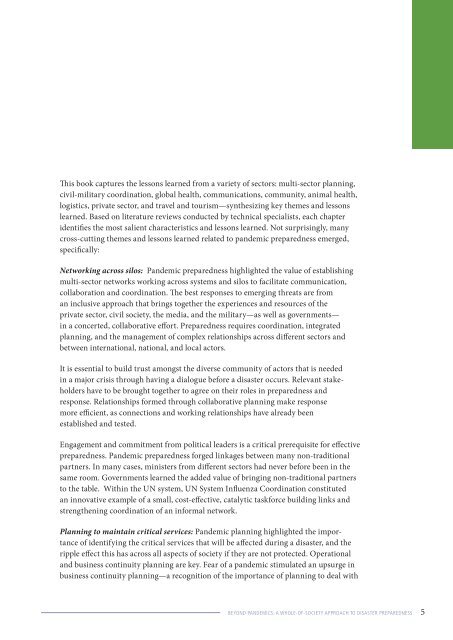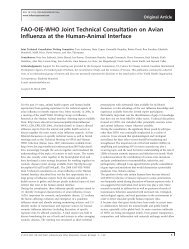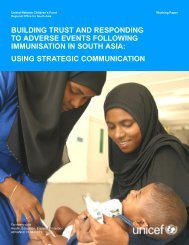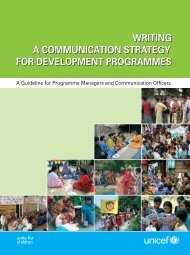beyond pandemics - Avian and Pandemic Influenza Communication ...
beyond pandemics - Avian and Pandemic Influenza Communication ...
beyond pandemics - Avian and Pandemic Influenza Communication ...
You also want an ePaper? Increase the reach of your titles
YUMPU automatically turns print PDFs into web optimized ePapers that Google loves.
This book captures the lessons learned from a variety of sectors: multi-sector planning,civil-military coordination, global health, communications, community, animal health,logistics, private sector, <strong>and</strong> travel <strong>and</strong> tourism—synthesizing key themes <strong>and</strong> lessonslearned. Based on literature reviews conducted by technical specialists, each chapteridentifies the most salient characteristics <strong>and</strong> lessons learned. Not surprisingly, manycross-cutting themes <strong>and</strong> lessons learned related to p<strong>and</strong>emic preparedness emerged,specifically:Networking across silos: P<strong>and</strong>emic preparedness highlighted the value of establishingmulti-sector networks working across systems <strong>and</strong> silos to facilitate communication,collaboration <strong>and</strong> coordination. The best responses to emerging threats are froman inclusive approach that brings together the experiences <strong>and</strong> resources of theprivate sector, civil society, the media, <strong>and</strong> the military—as well as governments—in a concerted, collaborative effort. Preparedness requires coordination, integratedplanning, <strong>and</strong> the management of complex relationships across different sectors <strong>and</strong>between international, national, <strong>and</strong> local actors.It is essential to build trust amongst the diverse community of actors that is neededin a major crisis through having a dialogue before a disaster occurs. Relevant stakeholdershave to be brought together to agree on their roles in preparedness <strong>and</strong>response. Relationships formed through collaborative planning make responsemore efficient, as connections <strong>and</strong> working relationships have already beenestablished <strong>and</strong> tested.Engagement <strong>and</strong> commitment from political leaders is a critical prerequisite for effectivepreparedness. P<strong>and</strong>emic preparedness forged linkages between many non-traditionalpartners. In many cases, ministers from different sectors had never before been in thesame room. Governments learned the added value of bringing non-traditional partnersto the table. Within the UN system, UN System <strong>Influenza</strong> Coordination constitutedan innovative example of a small, cost-effective, catalytic taskforce building links <strong>and</strong>strengthening coordination of an informal network.Planning to maintain critical services: P<strong>and</strong>emic planning highlighted the importanceof identifying the critical services that will be affected during a disaster, <strong>and</strong> theripple effect this has across all aspects of society if they are not protected. Operational<strong>and</strong> business continuity planning are key. Fear of a p<strong>and</strong>emic stimulated an upsurge inbusiness continuity planning—a recognition of the importance of planning to deal withBEYOND PANDEMICS: A WHOLE-OF-SOCIETY APPROACH TO DISASTER PREPAREDNESS 5











